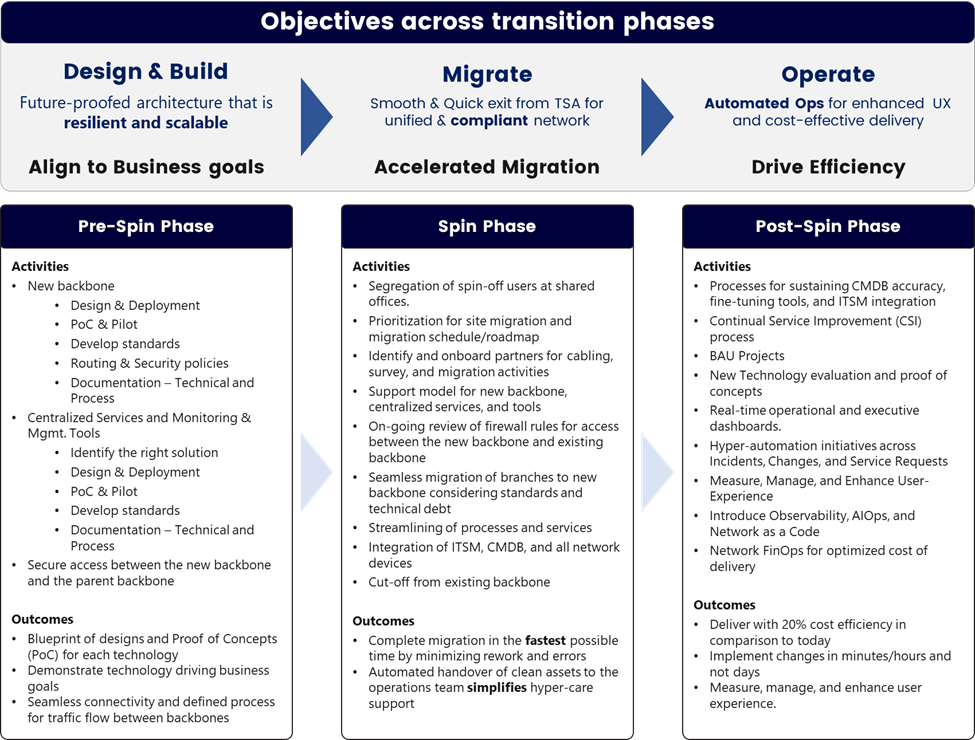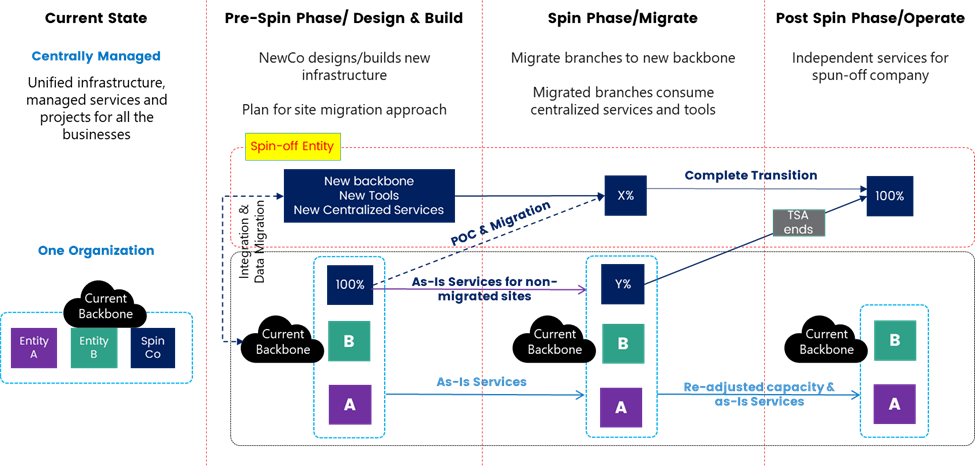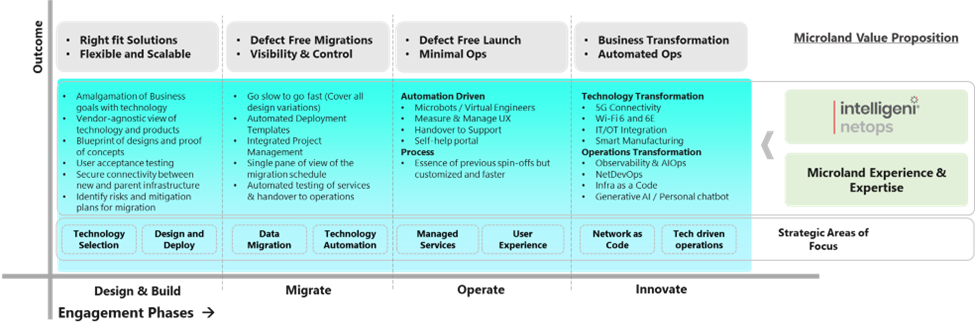Network Separation at the core of Spin-Offs

Introduction
Bigger is not always better, which is one reason why many large organizations look to split subsidiary companies or business units. As IPOs reached a standstill during the pandemic, spinoffs became the new IPOs. Spinoffs are expected to hit record levels in 2023-2024. Some of the noticeable examples from 2023 are – J&J, GE, and Kellogg’s among many others.
While the new company may continue to mirror the spirit and ethos of the parent company, it need not also be a digital twin from a technology perspective.
In the last blog, I touched upon Network Integrations in M&A. In this blog let us look at how technology, and network specifically is a driver to successful spinoffs and an accelerator to meet business goals.
In M&A the carved-out entity is usually integrated with a different parent company. Spinoffs usually require creating new IT infrastructure independent from existing parent organizations. Setting up new infrastructure from scratch is the most significant difference between M&As and spinoffs and poses a different challenge. While challenging, it also provides a unique and enviable opportunity for the team to start on a clean slate.
At Microland we start by understanding business goals and objectives and setting the right technology goals to enable business growth. The amalgamation and alignment of business and operational metrics become our guiding principle for all that is to follow.
Separation is all about preparation.
The process of separating an entity is spread out over several months or years depending on the size, scale, and complexity.
There are multiple different challenges that companies encounter during spin-offs.
To ensure that the spin-off is seamless and successful, appropriate planning and readiness must be ensured. For this, an assessment of possible challenges and risks that might impact the process needs to be identified and mitigation steps planned. Preparation and planning are the keys to a successful spin-off and here are some of the key aspects to consider during the spin-off process.
Technology Selection
- Technology Selection: Some companies look to replicate what they have, assuming that familiarity brings success. On the other hand, few companies look to extensively innovate by bringing in best-of-breed products and tools without duly considering the suitability and gestation period involved in adopting new technology during a dynamic and often changing period. It is important to diligently understand the business requirements apart from the pros and cons of each technology. It is advised for companies to run PoCs and define and measure success criteria to select technology solutions that are optimal for delivering business requirements.
- Right-sizing: Spin-offs provide an ideal opportunity to employ the ‘as a Service’ and cloud approach. Organizations can afford to scale gradually and manage the on-demand growth in infrastructure and financial requirements.
Data Migration and Integration
- Integration with Existing Systems: The new entity will continue to use the resources and systems of the parent company for a period defined in the TSA (Transition Service Agreement). One needs to build a secure system ensuring compatibility and interoperability to ensure one meets the requirements of data transfer and data residency. During the transition when the sites are being migrated to the new IT environment, to ensure seamless business operations and minimal impact on customer engagements, an interim network backbone is set up to connect the new network backbone and the parent organization’s network backbone to ensure connectivity.
- Data Transfer: Spinoffs often involve the transfer of data and information from the parent company to the new entity. Network technology facilitates secure and seamless data transfer, ensuring that critical information is migrated without loss or corruption.
Security and Compliance
- Data Security: Network technology plays a crucial role in maintaining the security of sensitive information and assets during the spinoff. This includes implementing secure communication channels, encryption, and access controls to protect data from unauthorized access during data transfer across the parent and spun-off company.
- Compliance Management: Spinoffs often need to adhere to industry regulations and compliance standards. It is important to ensure that the new entity operates within legal and regulatory frameworks and puts systems in place to be consistently compliant.
Operational Continuity
- Redundancy and Failover: Network technologies contribute to the establishment of redundant systems and failover mechanisms, ensuring operational continuity for the spinoff. This is critical to minimize disruptions and downtime during the transition phase.
- Knowledge Transfer: Network technology aids in knowledge transfer from the parent company to the spinoff through online training platforms, documentation repositories, and remote support systems. This helps in maintaining operational efficiency and expertise within the new entity.
Phased Approach
The part of separation requiring the utmost technical depth, foresight, and vision is establishing the Network and associated services from the ground up. This requires diverse teams to collaborate and create a forward-looking network infrastructure that not only becomes a base for the coming years but also for every other layer of infrastructure that engages and leverages the network for furthering user experience. It is important to take a vendor-agnostic approach and be cognizant of business goals, financial obligations & implications, and technical requirements during and beyond the TSA timeline. The following are the major technical components that have to be designed, built, and connected.
- Backbone Network that interconnects all the branches, data center, and cloud
- Cloud and Data Center which hosts the majority of the applications and the workloads
- Branches with a focus on SD-WAN, SD-LAN/LAN, and Wireless Network
- Centralized Services like DNS, DHCP, and IPAM are known as DDI, SASE, Remote Access, Vulnerability Management, and Monitoring and Management Tools
Considering the scale of work, we have divided it into 3 distinct phases with clearly defined activities and outcomes for each phase.
Microland Approach
Microland has a crack team focused on spin-offs, mergers, and acquisitions. The experience coupled with our platform, Intelligeni NetOps drives our differentiated approach. This platform helps to run audits of the network landscape. It automatically collects data to identify network assets, data repositories, traffic patterns, and services. This automated process significantly accelerates and simplifies the preparatory phase.
During the greenfield build and migration phase the platform serves as a centralized source of accurate information, offering real-time project progress updates. It plays a pivotal role in promoting collaboration among multiple stakeholders, which is essential for all separation endeavors. Additionally, it comes equipped with pre-defined configuration templates, and automated deployment checks reducing the risk of human errors during migration.
We enable a smooth transition from the parent company to the spinoff, supporting the establishment of a robust and independent network infrastructure. The combination of our platform approach and global experience minimizes noise during spinoff activities and maximizes the value delivered from Network & IT to meet business goals.























